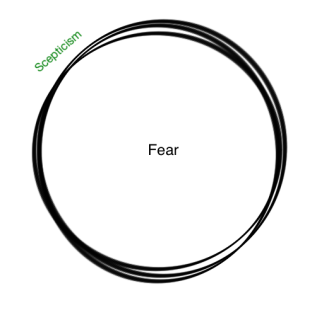Empathy requires us to take the time to understand the world from another’s perspective. Yet as someone who is troubled by our inability to respond to the potential impacts of climate change, how might I effectively engage with someone who denies it is a problem – the cynic, the troll*, the climate change sceptic?
This was a topic for discussion as part of the Science Online 2013 Adelaide Watch Party I attended in early February. One of the sessions we viewed was “Persuading the unpersuadable: Communicating science to deniers, cynics, and trolls”. Among the tips was using the “foot-in-the-door” strategy. This works to persuade someone to an idea they find difficult by first getting them agree to something small. So if agreeing to climate change is a step too far, perhaps we can both agree that the cost of living is rising, and then both agree that reducing energy use is a helpful strategy.
One of the ideas floated in the session was that cynics and scientists do share something in common – their scepticism. This interested me as we’re picking apart forms of scepticism in another project.
There are in effect two broad types of scepticism. The first is scientific scepticism, based on holding evidence open to allow for more evidence, or a better explanation. The second is the scepticism of cynics and deniers – based on criticising the evidence as insufficient or incorrect.
So while it sounds like a reasonable strategy, to start a discussion on the shared focus of questioning evidence, being sceptical, I don’t see much commonality apart from the language. These types of scepticism do not stem from the same drivers.
Perhaps there is a better way to consider two types of scepticism. One type of scepticism is based on open-mindedness. It’s the futurists’ mantra of “strong opinions, weakly held”. The barrier to ideas is porous, and information that confirms or denies the existing idea is sought. It also means that when we stand in this space, we allow ourselves to be vulnerable.

The other is based on fear. Information is sought that confirms the existing idea as a way of strengthening a position, fortifying a defence and protecting the idea. When we stand in this space, being right, and being seen as right is important.

As an aside while it might be true to say that scientific scepticism is based on open-mindedness, it does not necessarily follow that scientists’ scepticism is the same. The number of scientists at Science Online who felt safe to speak openly online because they had tenure was startling. Fear of limiting career opportunities can close down the porous boundary. Fear of looking stupid errs to the defence of ideas rather than exploration.
Really understanding someone, being empathetic, does not stop at finding a common language, it requires understanding the deeper motivations.
Persuading deniers and cynics to the evidence for climate change is not going to be successful because you’ve explained the scientific method (a shared language of scepticism) – but it may come about if you can acknowledge their fears.
[Days 25-28: Reflection]
*I’m not sure the trolls can be saved. My empathy circle clearly needs widening.





